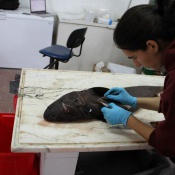PELAGICS: Structure and movement patterns in populations of the blue shark Prionace glauca
Understanding the processes governing the distribution of marine fish resources in time and space is essential for efficient fisheries management aimed at the long-term sustainability of the stocks. Elasmobranchs have received considerably less attention than teleosts in studies focusing on the delineation of stock structure, despite their higher vulnerability to population depletion when faced with similar fishing mortality rates[1]. Studies on oceanic pelagic sharks are particularly scarce due to the difficulty in accessing these widespread and highly mobile fish.
Oceanic pelagic sharks are the main by-catch component in tuna and billfish high-seas fisheries and, on occasions, the dominant fraction of the vessel’s catch[2]. Among these species, the blue shark (Prionace glauca) is likely the most exploited globally[2]. Initially discarded due to its low commercial value, increased demand for shark fins in the global fin market recently resulted in an increased interest in blue shark fins and meat[3]. Official statistics show that P. glauca comprises 50% of the reported pelagic shark catches per ocean basin[2], and estimates suggest it accounts for the highest proportion (17%) of fins traded in the global fin market[4].
Despite its importance as a fishing resource and its high fishing mortality, blue shark stock structure is largely unknown. This is of great concern in the Atlantic where fishing effort of pelagic fisheries and reported catches of P. glauca are highest[2,5]. Distinct stock units in the Mediterranean Sea, North and South Atlantic have been assumed for Atlantic blue sharks[6].This assumption is based on conventional tagging reports, indicating frequent transatlantic movements and limited transequatorial movements as well as between the Atlantic and the Mediterranean[7].
Inferring stock structure based mostly on conventional tagging data has many limitations. Conventional tags provide little spatial or temporal resolution of fish movements between the tagging and recapture events[8], and may miss important details of fish movement dynamics (e.g. phylopatry to discrete nursery or foraging grounds). Also, recapture records are highly dependent on volunteer reporting from recreational and commercial fishermen and on the distribution of fishing effort[8], resulting in a fishery-biased perspective of fish movement. Moreover, long-distance movements, e.g. across the North and the South Atlantic, may not result in effective genetic mixing (interbreeding) among individuals from different regions[9].
Molecular genetic markers are powerful tools for the identification of fishery stocks[9], and have been used in pelagic teleosts (e.g. Atlantic Bluefin tuna[S2], billfishes[S3]) and elasmobranchs[10 and references therein]. But until recently, the development of de novo molecular markers for non-model organisms has been expensive and time consuming. This has hampered population genetic studies in species like pelagic sharks, which have few genetic resources available. However, next-generation sequencing technology (NGS) now allows the development and screening of thousands of markers across the genome of non-model organisms, at an affordable cost[11].
Advances in tagging technology have also profoundly changed the amount and type of information available to researchers interested in studying fish movement dynamics and behavior[12]. In particular, electronic tags now allow for a near-real time tracking of individuals for extended periods, providing unprecedented access to fine-detail data on fish movement (e.g. 5).
The use of high-resolution genetic methods (e.g. NGS) and electronic tracking on the same species has great potential to unravel the processes governing the distribution of individuals and populations in time and space. We propose to use a combination of state-of-the-art technology in molecular genetics and in tracking devices to accurately delineate stock structure and elucidate the movement patterns in the blue shark. The expected outcomes of this study have direct application in the fisheries management of this highly exploited pelagic shark.
The research team includes highly experienced researchers in both tracking and molecular genetic studies. N. Queiroz has direct tagging experience with blue sharks, and has published several core publications in marine and behavioural ecology, focusing particularly on large pelagic fishes. The principal investigator (PI), A. Veríssimo, as well as J. McDowell (JM) and P. Alexandrino (PA), are proficient in the field of Population Genetics and have extensive experience in a variety of molecular genetic tools, including NGS. the PI and JM’s previous work on the population structure of widespread and highly mobile marine fish are of particular relevance to this project. PA has worked in a variety of marine organisms focusing on the evolutionary processes that shaped population diversification.
Jan Renee McDowell


